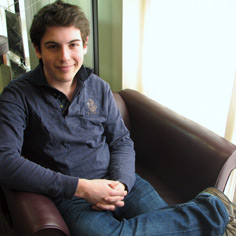
Andrew Johnson (S 2011)
President of CMU’s ski team, Andrew Carnegie Society Scholar, physics major
Bio
Having fun with physics
Andrew Johnson felt at home at Carnegie Mellon long before the first day of classes. Johnson came to campus for an Open HouseWeekend, and — since he was interested in pursuing a physics major — he spent some time hanging out in the Physics Department.
“I went to the Physics information session and met Dr. Ghosh and Dr. Garoff. They were so warm and so incredibly enthusiastic about the department. They gave us a full tour of all of the undergraduate facilities, and I was just immediately in love,” said Johnson, a native of Boston. “I went with physics and never looked back.”
Now a senior, Johnson’s connection with the Physics Department is stronger that ever. He is co-chairperson of the Physics Student Advisory Council (PSAC), and he’s a member of the Society of Physics Students (SPS). In those roles, Johnson is involved in everything from acting as a liaison between undergraduate physics majors and the department’s faculty and staff to organizing events like physics Jeopardy tournaments and physics charades.
But it’s not all fun physics games for Johnson. This past summer, he was an intern at Argonne National Laboratory, one of the U.S. Department of Energy’s oldest and largest national laboratories for science and engineering research. Between Argonne’s base outside of Chicago and his research group’s trip to CERN near Geneva, Switzerland, Johnson racked up the miles in pursuit of high-energy physics research.
“It was a hugely cool internship,” said Johnson, whose research project involved doing data analysis on the ATLAS detector – one of two detectors that record data from millions of proton-proton collisions generated by the Large Hadron Collider (LHC) at CERN. “I was thrilled to be working on data analysis for the LHC because it’s the frontier — it’s cutting-edge physics.”
When protons collide in the LHC, a whole jumble of interactions and other things happen all at once, explained Johnson. His job was to write a computer program that would analyze the data being generated during collisions and compare it to the predicted outcomes that are based on physics outlined in the Standard Model.
“We had to come up with a way to predict how many of these events are due to QCD background, which is what I was measuring, and not other things like top quark decays or muons arising from the decays of W bosons created in the collisions. I used some pretty cool statistics that I learned from my supervisor and also some cool programming to figure that out.”
When he’s not conducting research or leading the PSAC’s discussion of the next physics t-shirt design, you can find Johnson on the ski slopes. An avid skier since childhood, Johnson is currently the president of CMU’s ski team. Every weekend from mid-January through the end of February, he travels with the team to competitions in New York, Pennsylvania and West Virginia.
“With skiing and with physics, I like working with people who are better than me,” said Johnson. “They push me and make me better. And I’m surrounded by really amazing people at CMU.”